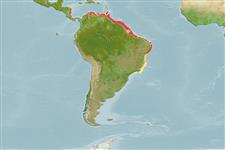>
Eupercaria/misc (Various families in series Eupercaria) >
Sciaenidae (Drums or croakers)
Etymology: Cynoscion: Greek, kyon = dog + Greek, odous = teeth + Greek, skion, skiaina = barbel, red mullet (Ref. 45335).
More on author: Cuvier.
Environment: milieu / climate zone / depth range / distribution range
Ecologie
marien; brak water demersaal; diepte 6 - 70 m (Ref. 3702). Tropical; 14°N - 24°S, 84°W - 34°W
Western Atlantic: Nicaragua to Santos, Brazil.
Grootte / Gewicht / Leeftijd
Maturity: Lm ? range ? - ? cm
Max length : 115 cm TL mannelijk / geslacht onbekend; (Ref. 40637); common length : 65.0 cm TL mannelijk / geslacht onbekend; (Ref. 3702); max. gepubliceerd gewicht: 4.4 kg (Ref. 125970)
Dorsale stekels (totaal): 11; Dorsale zachte stralen (totaal): 27-31; Anale stekels 2; Anale zachte stralen: 8. Greyish to brownish above, silvery below. Upper sides sometimes with inconspicuous minute dark dots. Dorsal fin dusky, its spinous portion black-edged. Soft dorsal fin with dark spots on each ray. Pectoral and pelvic fins as well as anal fin yellowish to orange. Caudal fin dusky. Inside mouth orange. Mouth large, distinctly oblique, lower jaw projecting. Upper jaw with a pair of large canine-like teeth at tip. Chin without barbels or pores. Snout with 2 marginal pores. Gas bladder with a pair of long, curved, horn-like appendages. Sagitta (large earstone) elongate, with a notch on dorsal margin. Soft portion of dorsal fin membranes unscaled except 2 or 3 rows of scales at base (Ref 51721).
Usually found over sandy mud bottoms in coastal waters near river mouths (Ref. 3702). Adults stay in deep waters during the day and swim to the surface at night (Ref. 35237). Juveniles inhabit estuaries. Marketed fresh; its flesh is of excellent quality (Ref. 3702). Its swim bladder is being used to make glue (Ref. 35237).
Levenscyclus en paargedrag
Maturiteit | Voortplanting | Paaien | Eieren | Fecunditeit | Larven
Cervigón, F., 1993. Los peces marinos de Venezuela. Volume 2. Fundación Científica Los Roques, Caracas,Venezuela. 497 p. (Ref. 9626)
Status op de Rode Lijst van het IUCN (Ref. 130435)
Gevaar voor de mens
Harmless
Gebruik door de mens
Visserij: commercieel; sportvis: ja
Meer informatie
Lokale namenSynoniemenMetabolismePredatorenEcotoxicologieVoortplantingMaturiteitPaaienPaaiaggregatiesFecunditeitEierenOntwikkeling van de eieren
ReferentiesAquacultuurAquacultuurprofielKweeklijnenGeneticaElectrophoresesErfelijkheidZiektesVerwerkingNutrientsMassaconversie
Tools
Speciale rapporten
Download XML
Internetbronnen
Estimates based on models
Preferred temperature (Ref.
123201): 26.7 - 28, mean 27.4 °C (based on 112 cells).
Fylogenetische diversiteitsindex (Ref.
82804): PD
50 = 0.5000 [Uniqueness, from 0.5 = low to 2.0 = high].
Bayesian length-weight: a=0.00661 (0.00531 - 0.00822), b=3.06 (3.04 - 3.08), in cm total length, based on LWR estimates for this species (Ref.
93245).
Trofisch niveau (Ref.
69278): 4.0 ±0.70 se; based on food items.
Weerstandsvermogen (Ref.
120179): laag, minimale populatieverdubbelingstijd 4,5-14 jaar (Preliminary K or Fecundity.).
Prior r = 0.26, 95% CL = 0.14 - 0.46, Based on 1 stock assessment.
Fishing Vulnerability (Ref.
59153): High to very high vulnerability (69 of 100).
Nutrients (Ref.
124155): Calcium = 67.7 [40.4, 126.2] mg/100g; Iron = 0.787 [0.413, 1.359] mg/100g; Protein = 18.5 [17.0, 20.3] %; Omega3 = 0.208 [0.114, 0.339] g/100g; Selenium = 65.4 [34.7, 122.1] μg/100g; VitaminA = 13.3 [5.1, 37.4] μg/100g; Zinc = 0.939 [0.680, 1.330] mg/100g (wet weight);
